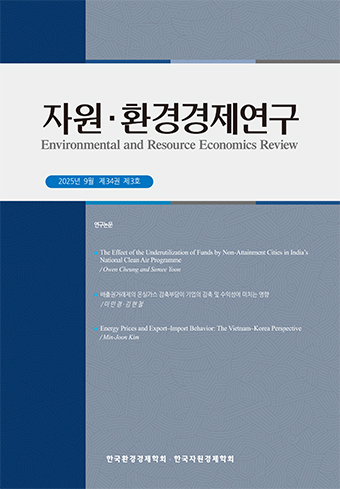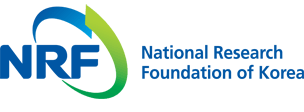-
Research Paper
-
The Effect of the Underutilization of Funds by Non-Attainment Cities in India’s National Clean Air Programme
인도 국가청정대기프로그램의 영향 분석: 비성취 도시의 예산활용의 역할에 관하여
-
Owen Cheung and Semee Yoon
정진호, 윤세미
- This paper analyzes the air pollution reduction effect of the National Clean Air Programme (NCAP) launched by the government of India in …
본 논문은 인도 정부의 국가청정대기프로그램(NCAP)이 대기질 개선에 미친 영향을 분석한다. 인도 정부는 대기질 기준을 충족하지 못하는 ‘비성취’ 도시에 대한 목표 자금 지원한 …
- This paper analyzes the air pollution reduction effect of the National Clean Air Programme (NCAP) launched by the government of India in 2019. In particular, we look at the impact of fund utilization for “non-attainment” cities on air quality improvements in 82 NCAP cities from 2019 to 2023. Using fixed-effects panel regression models, we analyze the relationship between changes in particulate matter (PM10) levels and various predictors, including the lagged use rate of allocated funds. We find that higher utilization rates of allocated funds in the previous year are associated with reductions in PM10 levels, with the effect being statistically significant at the 10% level. Specifically, a one-percentage increase in the lagged use rate correlates with a 0.100-unit decrease in PM10 levels, highlighting the delayed but meaningful impact of effective fund utilization on air quality. These findings underscore the importance of addressing the underutilization of funds to maximize the effectiveness of the NCAP and provide insights on future research directions and policy implications.
- COLLAPSE
본 논문은 인도 정부의 국가청정대기프로그램(NCAP)이 대기질 개선에 미친 영향을 분석한다. 인도 정부는 대기질 기준을 충족하지 못하는 ‘비성취’ 도시에 대한 목표 자금 지원한 바 있어, 각 도시별 예산 활용도를 주요 설명변수로 살펴본다. 이 연구는 2019년부터 2023년까지 82개 NCAP 도시의 대기질 개선 효과 분석을 위해 고정효과 패널 회귀 모델을 사용하여 미세먼지(PM10) 농도의 변화와 할당된 예산의 1년 시차(lag) 간의 관계를 분석한다. 그 결과, 전년도에 할당된 예산의 사용률이 높을수록 PM10 수치 감소와 연관되어 있으며, 그 효과는 10% 유의수준에서 통계적으로 유의하다. 특히, 사용률이 1% 증가하면 PM10 수치가 0.100 단위 감소하는 것으로 나타나 효과적인 예산 활용이 대기질에 미치는 영향이 상당한 것으로 나타났다. 이러한 연구 결과는 NCAP의 효과를 극대화하기 위해 예산 활용률 저조 문제를 해결하는 것이 중요함을 지적하며 향후 연구에서 고려할 요인들을 제기한다.
-
The Effect of the Underutilization of Funds by Non-Attainment Cities in India’s National Clean Air Programme
-
Research Paper
-
The Effect of GHG Reduction Burden of the Korea Emission Trading Scheme on Firms’ Reduction Performance and Profitability
배출권거래제의 온실가스 감축 부담이 기업의 감축 및 수익성에 미치는 영향
-
Minkyung Lee and Hyunchul Kim
이민경, 김현철
- In the transition to a low-carbon economy, it is imperative for firms to adeptly comply with increasingly stringent environmental policies. This study …
본 연구는 배출권거래제의 감축 부담이 기업의 배출량 및 수익성에 미치는 영향을 실증적으로 분석한다. 이를 위해, 국내 배출권거래제 할당 대상 업체 중 산업 …
- In the transition to a low-carbon economy, it is imperative for firms to adeptly comply with increasingly stringent environmental policies. This study examines the ramifications of ETS in Korea, by estimating firms’ net allowance demands and classifying them into excessive emission and surplus allowance categories for analysis. Using panel data from 2019 to 2022, the impact of GHG reduction burden and net purchase of allowance through trading on emission growth rate and profitability was analyzed. Our findings show that at the firm level an increase in surplus allowances leads to a higher emission growth rate and is positively associated with firm profitability. In addition, an increase in net allowance purchases tends to lower the emission growth rate. Our study provides policy implications regarding firms’ decisions of reducing emissions and their strategic responses to adjustments of emission trading scheme.
- COLLAPSE
본 연구는 배출권거래제의 감축 부담이 기업의 배출량 및 수익성에 미치는 영향을 실증적으로 분석한다. 이를 위해, 국내 배출권거래제 할당 대상 업체 중 산업 부문에 해당하는 기업을 대상으로 배출권 순수요를 산정하고, 이를 초과배출량과 잉여배출권으로 구분하였다. 또한, 기업의 온실가스 감축 부담(초과배출량, 잉여배출권) 및 배출권 순매수량이 온실가스 배출량 증가율과 기업 수익성에 미치는 영향을 패널 회귀 분석하였다. 분석 결과, 배출권 잉여 기업의 배출권 잉여량 증가는 온실가스 배출량 증가율 상승에 영향을 미쳤으며, 기업 수익성과도 유의미한 양(+)의 관계를 나타냈다. 또한, 배출권 순매수량의 증가는 다음 해 배출량 증가율 감소에 영향을 주는 것으로 나타났다. 본 연구는 배출권거래제 할당 대상 업체의 온실가스 감축 부담의 영향과 시장 거래의 효과를 파악하여, 정책 설계 및 기업의 전략적 대응 방향에 대한 시사점을 도출하는 데에 기여할 수 있다.
-
The Effect of GHG Reduction Burden of the Korea Emission Trading Scheme on Firms’ Reduction Performance and Profitability
-
Research Paper
-
Energy Prices and Export–Import Behavior: The Vietnam–Korea Perspective
에너지 가격과 수출입 행태: 베트남–한국의 관점
-
Min-Joon Kim
김민준
- This paper mainly aims to assess the short-run and long-run impacts of oil price shocks, along with macroeconomic variables, on imports and …
본 논문은 유가 충격과 거시경제 변수가 수입과 수출에 미치는 단기 및 장기적 영향을 평가하는 것을 주된 목적으로 한다. 2008년 1월부터 2024년 12월까지의 …
- This paper mainly aims to assess the short-run and long-run impacts of oil price shocks, along with macroeconomic variables, on imports and exports. We apply the Fourier autoregressive distributed lag (FARDL) model to examine the bilateral import and export functions between Vietnam and Korea over the period from January 2008 to December 2024. The results demonstrate that oil price shocks affect exports and imports only in the short run, with minimal long-run effects. Additionally, Korea’s real income is the key driver in the long-run export model, while Vietnam’s real income plays a major role in the short-run import model. The bilateral real exchange rate also proves significant in the long-run export function. These findings provide policymakers with valuable insights into the key factors influencing bilateral trade between Vietnam and Korea. Such insights can support the development of effective policies to address fluctuations in oil prices and other macroeconomic variables, thereby helping to maintain a balanced trade relationship.
- COLLAPSE
본 논문은 유가 충격과 거시경제 변수가 수입과 수출에 미치는 단기 및 장기적 영향을 평가하는 것을 주된 목적으로 한다. 2008년 1월부터 2024년 12월까지의 기간을 대상으로 베트남과 한국 간 양자 수출입 함수를 분석하기 위해 푸리에 자기회귀분산지연(Fourier autoregressive distributed lag - FARDL) 모형을 적용한다. 분석 결과, 유가 충격은 단기적으로 수출과 수입에 영향을 미치지만 장기적 효과는 제한적인 것으로 나타난다. 또한 장기 수출 모형에서는 한국의 실질소득이 핵심 요인으로 작용하는 반면, 단기 수입 모형에서는 베트남의 실질소득이 중요한 역할을 한다. 아울러 양국 간 실질환율 역시 장기 수출 함수에서 유의한 영향을 미치는 것으로 확인된다. 이러한 결과는 베트남과 한국 간 양자 무역에 영향을 미치는 주요 요인에 대한 중요한 시사점을 제공한다. 또한 유가 및 기타 거시경제 변수의 변동에 대응할 수 있는 효과적인 정책 수립을 지원하여 균형 잡힌 무역 관계 유지에 기여할 수 있다.
-
Energy Prices and Export–Import Behavior: The Vietnam–Korea Perspective


 자원·환경경제연구
자원·환경경제연구






